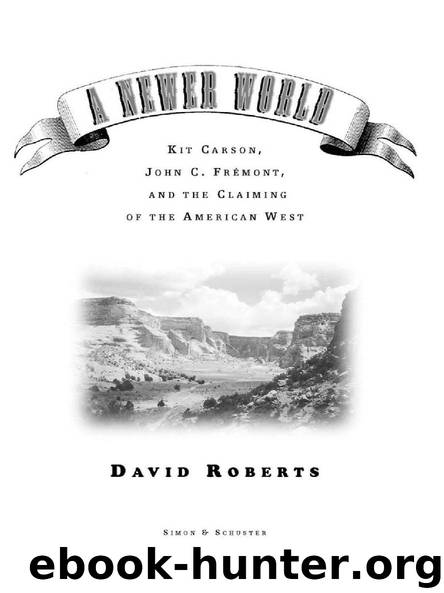A NEWER WORLD by David Roberts

Author:David Roberts
Language: eng
Format: epub
Publisher: SIMON & SCHUSTER
Published: 2001-07-15T00:00:00+00:00
Denny Creek
Here
John C. Fremont
Camped on His Second
Journey of Exploration
In May of 1846, Was Attacked
By Indians and Lost Three Men
For One of Whom He Named
The Stream
Despite the numbering error (it was Frémont’s third journey in the West), the plainspoken legend eschews the jingoistic tone so common to monuments to slain American heroes. It states a historic fact, avoiding questions of motivation or blame.
No plaque or monument stands at the site of Dokdokwas. On either bank of the crystalline Williamson River, tall grasses billow in the wind. There is no sign that anyone ever lived here.
The Klamath people, however, flourish today around the town of Chiloquin, east of the lake. Here in 1864, the Klamath reservation was established. After Washington bureaucrats forced the outnumbered Modocs to live cheek-by-jowl with their hated enemies, in 1872 a group of 160 men, women, and children under the charismatic leader Kientpoos, or Captain Jack, fled the reservation and occupied the lava beds south of Tule Lake, at the heart of their own homeland. When the U.S. Army marched on these fugitives, the Modoc War began; it would prove to be one of the bitterest of all the Indian campaigns, the only one in which a full-fledged general (E. R. S. Canby) was killed.
The reservation was officially terminated in the early 1950s. Today, as the Klamath Tribes, the Modocs, Klamaths, and their erstwhile neighbors the Yahooskins live in multiethnic harmony on land they themselves own, where once the reservation hemmed them in. Among Native Americans, these people are relatively well off, sharing the profits of a major timber industry and their jointly run Kla-Mo-Ya Casino. The Klamaths alone number some 3,200 souls today. In towns such as Klamath Falls, unfortunately, a wide streak of anti-Indian prejudice still poisons Anglo hearts. (Hanging in the Favell Museum, which boasts of its collection of 60,000 Indian arrowheads, is a painting called “The Death of General Canby,” in which the Modoc warriors are portrayed as wild, slackjawed, apelike monsters.)
But Frémont’s attack on Dokdokwas has not been forgotten. As if recalling an event that happened a few years ago, Gordon Bettles, culture and heritage director for the Klamath Tribes, conjures up the fatal day: “The men were out hunting. Old men, women, and children were all that was left at camp. Without warning, the soldiers went in and started the slaughter. Some boys got away, swimming in the river, using reeds to breathe under water.
“In school, we Klamaths were told this should all be forgotten. But the event is very vivid in oral memory. We wonder how they can honor that man. Frémont set the pattern as to how we would be treated for the next fifty years.
“Some members of our tribe have been over there at the right time of year, and they can hear horses whinnying, rifle shots, and the ghosts of women and children screaming.”
Download
This site does not store any files on its server. We only index and link to content provided by other sites. Please contact the content providers to delete copyright contents if any and email us, we'll remove relevant links or contents immediately.
| Africa | Americas |
| Arctic & Antarctica | Asia |
| Australia & Oceania | Europe |
| Middle East | Russia |
| United States | World |
| Ancient Civilizations | Military |
| Historical Study & Educational Resources |
1787 by Nick Brodie(1206)
The 2012 Story by John Major Jenkins(1047)
Bury My Heart at Wounded Knee by Dee Brown(1031)
Plagues and Peoples by William H. McNeill(892)
Witchcraft in Early North America by Alison Games(889)
Native American Folklore & Traditions by Elsie Clews Parson(853)
Ada BlackJack by Jennifer Niven(845)
Tending the Wild by Anderson M. Kat(842)
Empire of the Summer Moon by S. C. Gwynne(825)
The Wisdom of the Native Americans by Kent Nerburn(806)
0735220891 by Craig Johnson(804)
They Called Me Number One by Bev Sellars(766)
The Truth About Stories by Thomas King(744)
American Serengeti by Dan Flores(743)
The Killing of Crazy Horse by Thomas Powers(728)
An Inca Account of the Conquest of Peru by Ralph Bauer(713)
House of Rain by Craig Childs(704)
Sand Talk by Tyson Yunkaporta(687)
Unworthy Republic by Claudio Saunt(665)
